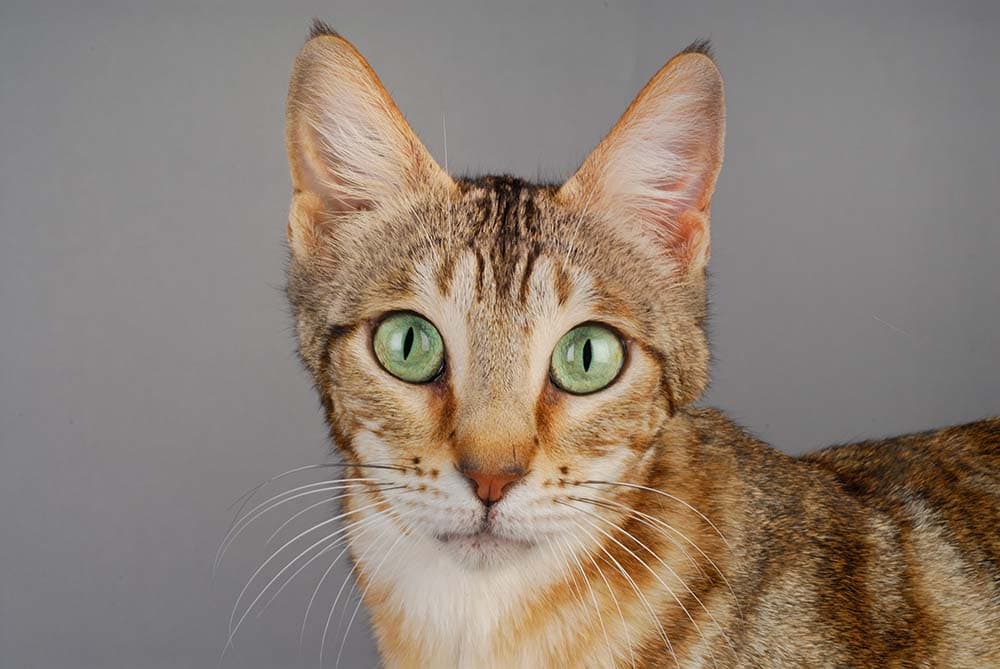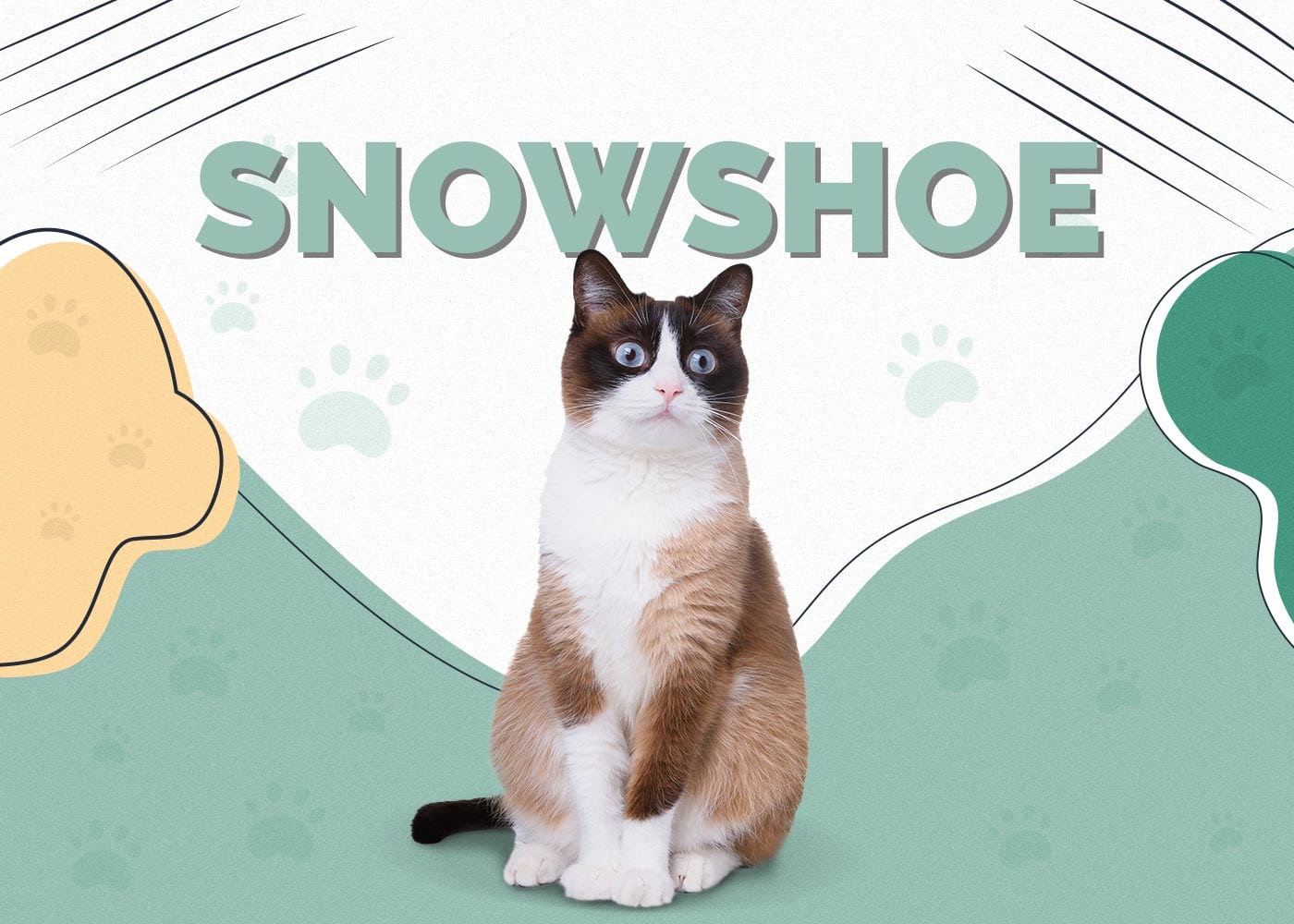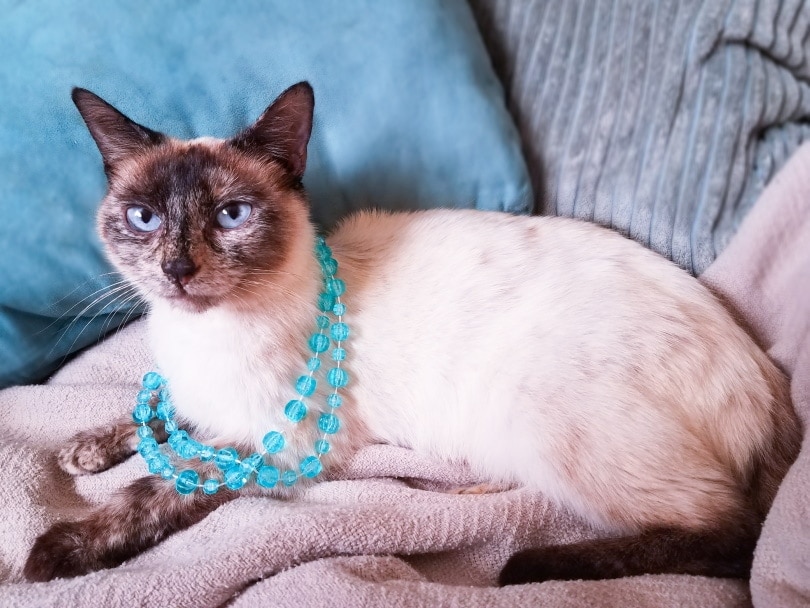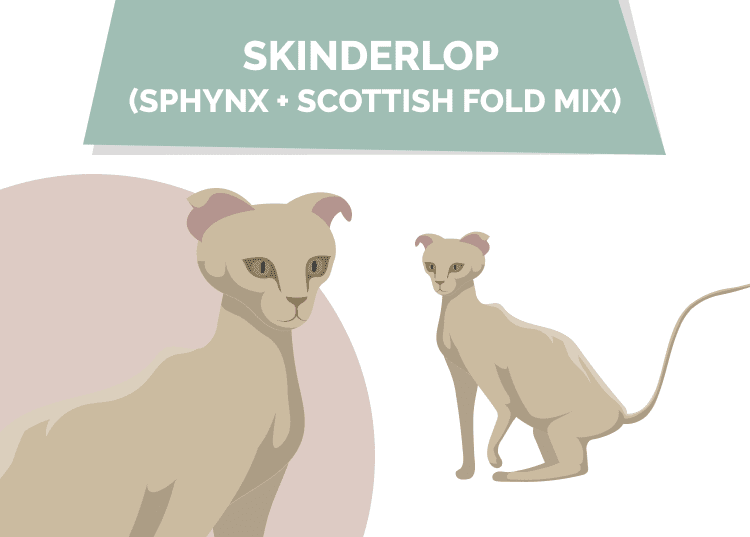Sokoke Cat Breed Info: Pictures, Temperament & Traits
Updated on

| Height: | 7 – 8 inches |
| Weight: | 5.5 – 11 pounds |
| Lifespan: | Up to 15 years |
| Colors: | Brown tabby patterns |
| Suitable for: | Active homes and families with older children |
| Temperament: | Playful, lively, agile, loyal, social, intelligent |
The exotic Sokoke could easily be mistaken for the common Tabby. But a closer look at these Kenyan natives reveals some distinguishing characteristics. Sokokes appear to walk on their tiptoes, as their back legs are slightly longer than their front legs. They are long and slender felines with sloped backs. A Sokoke has almond eyes and ears that look just a little too big for the rest of their bodies. Pretty adorable, right?
Sokokes also have great personalities. While they don’t like to cuddle, they will follow their humans around. They walk well on a leash and tolerate other pets. Doesn’t this sound like the recipe for an ideal housecat?
The International Cat Association (TICA) classifies the Sokoke as a “natural breed” of cats. This designation means that the Sokoke breed evolved naturally without human involvement. So how did Sokokes become domesticated? And where can you buy or adopt one? Let’s dive deeper into this exotic breed to decide if they’re the right pet for you.
Sokoke Kittens
North American Sokoke breeders are few and far between. You may not find active breeders in the United States. You may come across social media posts about Sokokes or Sokoke mixes for sale or adoption. While these people can have honest intentions, they are often mistaken. Sokokes are sometimes confused for more common tabbies. If you’re unsure about a kitty’s breed, you can use a cat DNA test.
If you have your heart set on a Sokoke kitten, you will probably have to purchase one from Europe.
3 Little-Known Facts About the Sokoke
1. They can swim.
Sokokes do more than just tolerate water—they enjoy it! They’re natural swimmers. Don’t be surprised if your Sokoke hops into the bathtub with you or joins you for a lap around the pool.
2. Sokokes are dogs at heart.
You can easily train a Sokoke. They won’t give off the stereotypical “catitude” when you teach them tricks. And unlike many other cats, they will gladly wear a harness and let you lead them on a walk.
3. Sokokes are named for their native home.
The domestication of Sokokes has a somewhat murky history. Many sources state that in the 1970s, a woman named Jeni Slater took in a wild Sokoke and her kittens. The number of domesticated Sokokes grew from there. The breed is named after where Slater first saw the cats, near the Arabuko Sokoke Forest on Kenya’s coast.

Temperament & Intelligence of the Sokoke
Sokokes are social felines, but not in the traditional sense. These cats aren’t much for cuddling and being held. They will, however, follow their favorite humans around, but they do not enjoy spending time alone. Sokokes benefit from the companionship of other cats and dogs.
Forget the stereotype of the sleepy, napping housecat. Sokokes are on the move all the time. They have a reputation as athletic climbers. Don’t be surprised if you find your Sokoke perched on a curtain rod or kitchen cabinets.
Certain breeds, like Siamese cats and Savannah cats, can live up to 20 years. However, Sokokes often live to 15, which is the average lifespan for a domesticated cat.
Are These Cats Good for Families? 👪
Sokokes would be a welcome addition to households that can tolerate their energy levels. They are best suited for adults and families with school-aged children. A Sokoke’s rambunctiousness could be too much for babies and small children.
Does This Breed Get Along with Other Pets?
Yes! Sokokes are known for their ability to get along with dogs and other cats. All pets benefit from a slow introduction to each other, but Sokokes should quickly adapt. However, Sokokes are wary around strangers and unkown animals, and they’re not afraid to use their favorite weapons (teeth and claws) when they feel threatened. They can accept other cats and canines as roommates, but other pets like reptiles, fish, or rodents are unsuitable
Things to Know When Owning a Sokoke:
Food & Diet Requirements 🐡
Healthy Sokokes don’t have any special dietary requirements. Your veterinarian can help you determine how many calories your cat should eat each day. Kittens, nursing mothers, and senior cats have different caloric needs. Whether you serve wet or dry food comes down to your budget and your cat’s preference.
Exercise 🐈
Sokokes are naturally active and won’t need much coaxing to exercise. They love to scale vertical surfaces and are natural climbers. Your Sokoke will appreciate a large and sturdy cat tree. It’s known for its ability to be leash-trained, and a daily stroll can help your Sokoke fight off boredom and burn off extra energy.
Training 🧶
Unlike many other cat breeds, Sokokes aren’t stubborn or aloof. These cats are easy to train and love human interaction.
Grooming ✂️
Sokokes are low maintenance when it comes to grooming. Because they have short hair, Sokokes don’t shed much. A good brushing once a week is usually sufficient. Keeping their nails clipped, checking their ears for mites and infections, and periodically brushing their teeth will keep them active and healthy.
- See Also: 11 Best Waterless Cat Shampoos
Health and Conditions 🏥
Thanks to natural selection and little human interference, Sokokes are generally healthy. They aren’t plagued by any specific health conditions.
Sokokes can experience any of the common illnesses that affect other domesticated cats, including fleas, urinary tract infections, and diabetes.
- The best way to protect your Sokoke from fleas is to use with an oral or topical preventative medication. Fleas are usually a minor annoyance if you catch them early. Over time, cats with untreated fleas can become anemic.
- Your cat might disagree, but we’ve categorized urinary tract infections as a “minor” condition. While a UTI can cause severe pain and discomfort, most are easily treated with an antibiotic.
- Vomiting in cats isn’t a condition, per se. But it can be a symptom of a serious underlying condition. Pet owners should take vomiting seriously, as cats can quickly become dehydrated.
- Approximately 1% of all pet cats in the U.S. will develop feline diabetes. The best way to prevent this disease is to help your Sokoke maintain a healthy weight.
- Obesity is a growing problem for domesticated cats. Experts estimate that half of all cats are overweight.
Male vs Female
Female Sokokes are smaller than their male counterparts. There aren’t any significant personality differences noted between the sexes. Sokokes are rare, so not having a preference can help speed up the purchase or adoption process.
Final Thoughts
Sokokes are new to the house pet scene. The first Sokokes were domesticated in the 1970s in Kenya. Unfortunately, the Sokoke is a rare breed, since the cats are easy to train. Most Sokokes will walk on a leash, just like a dog, and unlike other breeds, they’re simple to groom.
Sokokes, as a whole, are a healthy breed. They do not require a specialized diet, but they need to visit the vet regularly to ensure they stay healthy. It may difficult or even impossible to find Sokoke kittens in the U.S., but with luck, you may be able to bring home one of the spirited kitties.
Featured Image Credit: Omerfarukguler, Shutterstock










